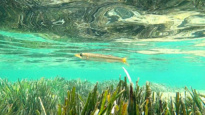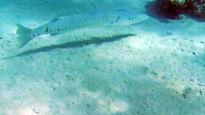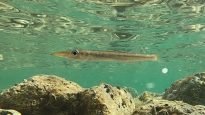Sphyraena - Sphyraenidae
European barracuda - Sphyraena sphyraena
Great Barracuda - Sphyraena Barracuda
Yellowmouth barracuda - Sphyraena viridensis
The Sphyraenidae family includes 26 species of carnivorous fish united in the single genus Sphyraena, commonly known as Barracuda and belonging to the order Perciformes.

Distribution and habitat
The barracudas inhabit all tropical seas, in particular the Caribbean Sea but are also present in the western Atlantic, in the entire Mediterranean Sea with four species and in the Red Sea.
Description
Very elongated body, head also elongated, provided with large eyes and strong jaws, with two rows of protruding and sharp teeth. The upper jaw is not protractile, as is the case in most fishes. There are dorsal fins on the back, the tail is strongly forked. The lateral line is well developed. The skin is covered with small smooth scales. The livery is silvery white, with lateral brown lines. The dimensions vary from 45 cm of the minor species up to 1.80 meters (Sphyraena barracuda).

Diet
Barracudas have a well-deserved reputation as insatiable and ferocious predators. Although their diet varies according to the habitat, their most frequent preys are fish and cephalopods, and sometimes even their own young. The barracuda begins its attack by investing its prey at great speed, thanks to its elongated and hydrodynamic body. Furthermore, its very keen eyesight allows it to hunt where the waters are more murky. It is said that, when they have grouped the preys, they gather them in a large shoal to increase the effectiveness of the operation. Adults prefer deep waters, while juveniles inhabit coastal areas and shallow sandy bottoms. They swim and hunt in small bands, which is unusual in other predatory species. The larger ones, on the other hand, use to hunt alone.

Reproduction
In the breeding season the barracudas aggregate in very numerous herds. The Mediterranean species reproduces between September and April, a period in which the females deposit their eggs in the shallow waters of the coastal areas. The youngest produce up to 5,000 eggs, while the adult specimens can deposit up to 300,000. The fry begin hunting immediately after birth.
https://it.wikipedia.org/wiki/Sphyraenidae
https://en.wikipedia.org/wiki/Barracuda
Gallery



